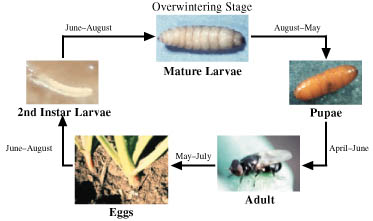
North Dakota State University
NDSU Extension Service
December 1998
Scott Armstrong and Bob Dregseth
NDSU Department of Entomology
The sugarbeet root maggot (SBRM) overwinters as a mature larvae about 12-18 inches in the soil. In the spring, the larvae move up to within 1 to 2 inches of the soil surface and pupate. From the middle to the end of May, adults begin to emerge. Peak fly emergence occurs between the first and third week of June. Adult flies emerge for the next four to six weeks, mate and deposit eggs around the base of sugarbeet plants. Eggs hatch in about three days and the new larvae move downward to feed (scar) the tap root and lateral roots. Larval SBRM will feed on the beet through July and August.

Rating sugarbeets for sugarbeet root maggot feeding injury (Blickenstaff et.al., 1977) is important in determining effectiveness of control measures and for estimating populations for the following season. For example, if damage ratings (on a 0 to 5 scale) were in the 3 to 5 range from last year's sugarbeets, and the new crop was being planted in close proximity, the threat of heavy SBRM populations is high. There can be various degrees of scarring on the beet root surface depending on the number of feeding larvae. The following pictures show sugarbeets assigned a damage rating where a 0 indicates no scarring and 5 indicates heavy scarring (essentially a dead sugarbeet). If the tap root is severed when the sugarbeet is in the seedling stage and dry soil conditions prevail, stand reductions occur. Environmental conditions can be an important factor on yield response to higher damage ratings. Soil conditions, (i.e. heavy rain, drought, etc.) effect SBRM populations and the effectiveness of granular insecticides. For further SBRM control recommendations, consult the current sugarbeet production guide.
Rating sugarbeets for SBRM feeding injury is a very simple task that should not require much time. Sugarbeets can be rated for damage when they reach 14 fully expanded leaves. Start sampling by removing a randomly selected beet from the corner of a sugarbeet field, at least 50 feet from the edge of the field, and away from the headlands. If beets are too soiled to give an accurate rating, use a small bucket of water and a scrub brush to clean the beets so accurate examinations can be made. Walk 20 paces down the row and move 20 rows over. Select and rate a beet at that site. If no beet is found at that location because of poor plant stand due to serious feeding, rate the beet as a 5. Continue this procedure until at least 30 beets have been rated. The general sampling distribution should be diagonal from one corner of the field to the other. Add all the damage rating scores together and divide by the total number of beets inspected for an average score. Conducting damage ratings will give good estimates of SBRM densities in any given field.
0 = no scars
1 = 1-4 small (pin head size) scars
2 = 5-10 small scars, up to 3 large scars
3 = more than 3 large scars
4 = ½ to ¾ of the root are blackened by scars
5 = More than ¾ of root area blackened, an obviously
heavily damaged or dead beet
- 2 mm, small scar
-- 5 mm, medium scar
--- 10 mm, large scar
Damage Rating = 0 (33KB color photo)
Damage Rating = 1 (34KB color photo)
Damage Rating = 2 (30KB color photo)
Damage Rating = 3 (29KB color photo)
Damage Rating = 4 (34KB color photo)
Damage Rating = 5 (38KB color photo)
Blickenstaff, C.C., R.E. Peckenpaugh and R.E. Mahrt. 1977. Rating sugarbeets for damage by
the sugarbeet root maggot (Tetanops myopaeformis). J. Am. Soc. Sugar Beet
Technol. 19(3): 188-191.
December 1998
NDSU Extension Service, North Dakota State University of Agriculture and Applied
Science, and U.S. Department of Agriculture cooperating. Sharon D. Anderson, Director,
Fargo, North Dakota. Distributed in furtherance of the Acts of Congress of May 8 and June
30, 1914. We offer our programs and facilities to all persons regardless of race, color,
national origin, religion, sex, disability, age, Vietnam era veterans status, or sexual
orientation; and are an equal opportunity employer.
This publication will be made available in alternative format upon request to people with
disabilities (701) 231-7881.
North Dakota State University
NDSU Extension Service